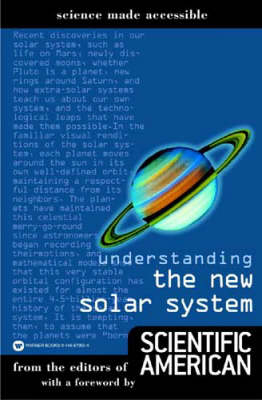
Understanding the New Solar System
Seiten
2002
Little, Brown & Company (Verlag)
978-0-446-67953-4 (ISBN)
Little, Brown & Company (Verlag)
978-0-446-67953-4 (ISBN)
- Titel ist leider vergriffen;
keine Neuauflage - Artikel merken
This volume reveals the latest knowledge of the composition and nature of our solar family. Here you'll discover what lies beyond the orbit of Pluto, which solar body is the most volcanically active, and which solar system bodies have atmospheres and may harbour primitive life.
The solar system - our sun and the planets and other bodies that orbit it - has remained essentially the same for hundreds of millions years. What, then, is the New Solar System? Quite simply what's new is our understanding of what in fact makes up the solar system and our deeper understanding of long-known objects such as the planets, their satellites, comets and asteroids. The ancient Romans observed and noted the motions of the known planets at that time but it wasn't until 1781 that Uranus was discovered. Neptune was discovered in 1846 and Pluto in 1930. Pluto's moon, Charon, was only discovered in 1978, or about the time that robotic exploration of the solar system became a serious undertaking. This book reveals the latest knowledge of the composition and nature of our solar family. Here you'll discover what lies beyond the orbit of Pluto, which solar body is the most volcanically active, and which solar system bodies have atmospheres and may harbour primitive life.
The solar system - our sun and the planets and other bodies that orbit it - has remained essentially the same for hundreds of millions years. What, then, is the New Solar System? Quite simply what's new is our understanding of what in fact makes up the solar system and our deeper understanding of long-known objects such as the planets, their satellites, comets and asteroids. The ancient Romans observed and noted the motions of the known planets at that time but it wasn't until 1781 that Uranus was discovered. Neptune was discovered in 1846 and Pluto in 1930. Pluto's moon, Charon, was only discovered in 1978, or about the time that robotic exploration of the solar system became a serious undertaking. This book reveals the latest knowledge of the composition and nature of our solar family. Here you'll discover what lies beyond the orbit of Pluto, which solar body is the most volcanically active, and which solar system bodies have atmospheres and may harbour primitive life.
SCIENTIFIC AMERICAN is the oldest continuously published magazine in America: for all of that time it has been the leader in communications about science and technology.
| Erscheint lt. Verlag | 1.5.2003 |
|---|---|
| Verlagsort | New York |
| Sprache | englisch |
| Maße | 134 x 205 mm |
| Gewicht | 155 g |
| Themenwelt | Sachbuch/Ratgeber ► Natur / Technik ► Weltraum / Astronomie |
| Naturwissenschaften ► Physik / Astronomie ► Astronomie / Astrophysik | |
| ISBN-10 | 0-446-67953-4 / 0446679534 |
| ISBN-13 | 978-0-446-67953-4 / 9780446679534 |
| Zustand | Neuware |
| Haben Sie eine Frage zum Produkt? |
Mehr entdecken
aus dem Bereich
aus dem Bereich
Perspektiven auf die Menschheit
Buch | Hardcover (2024)
Klett-Cotta (Verlag)
25,00 €
auf der Suche nach neuen Planeten und außerirdischem Leben
Buch | Hardcover (2024)
Droemer (Verlag)
24,00 €


